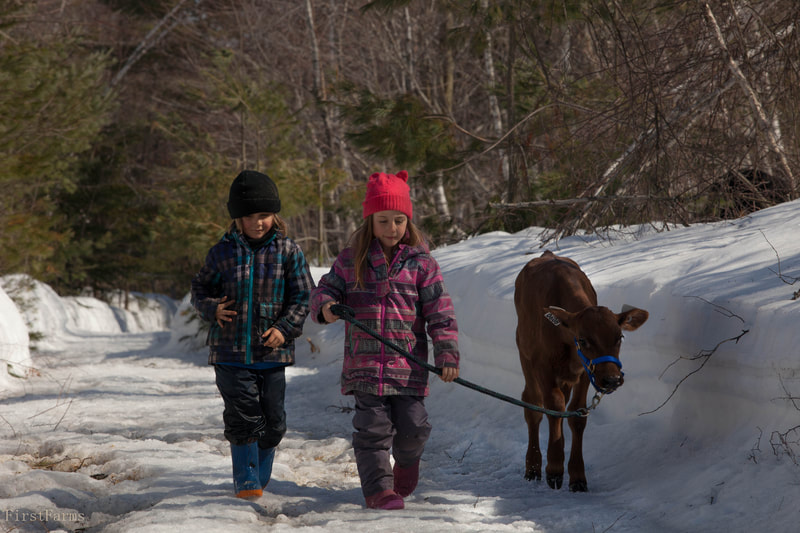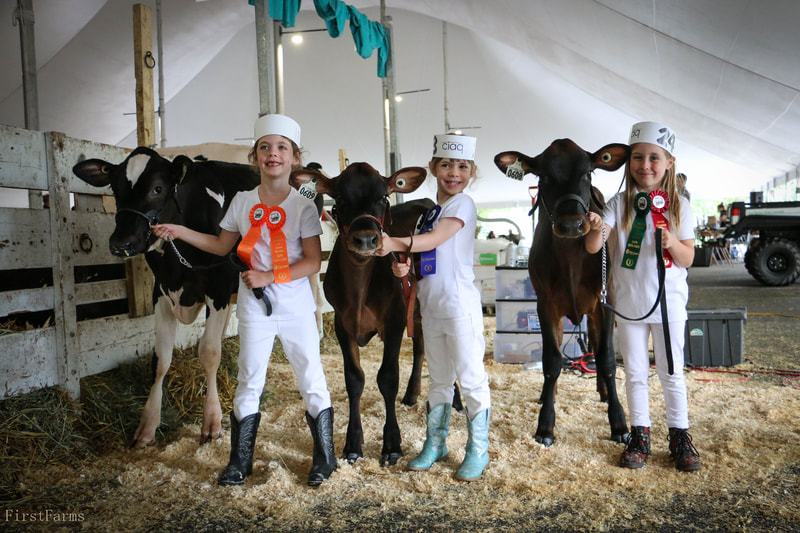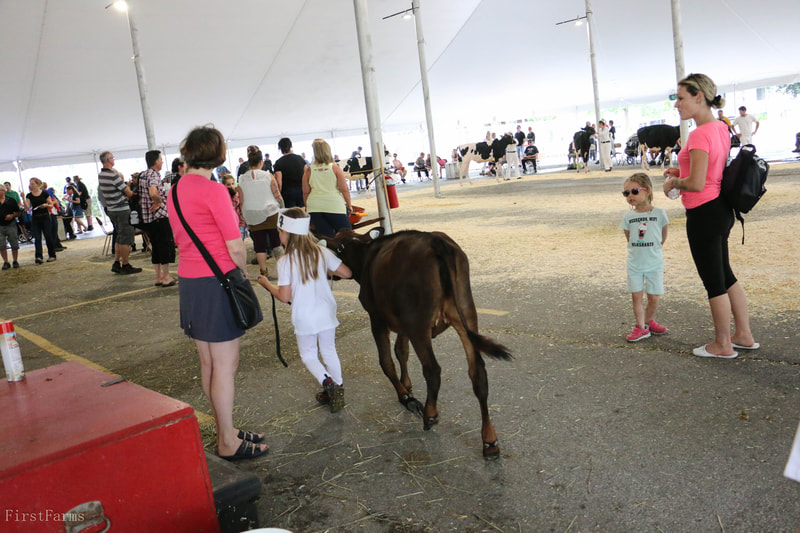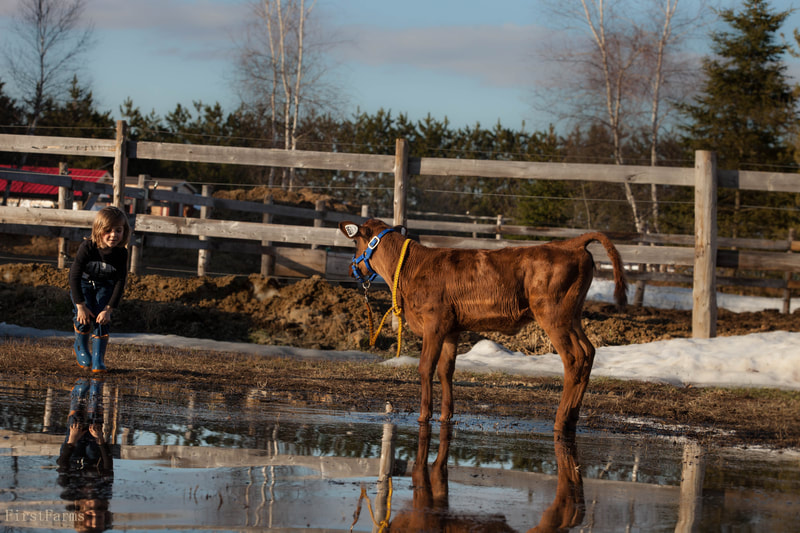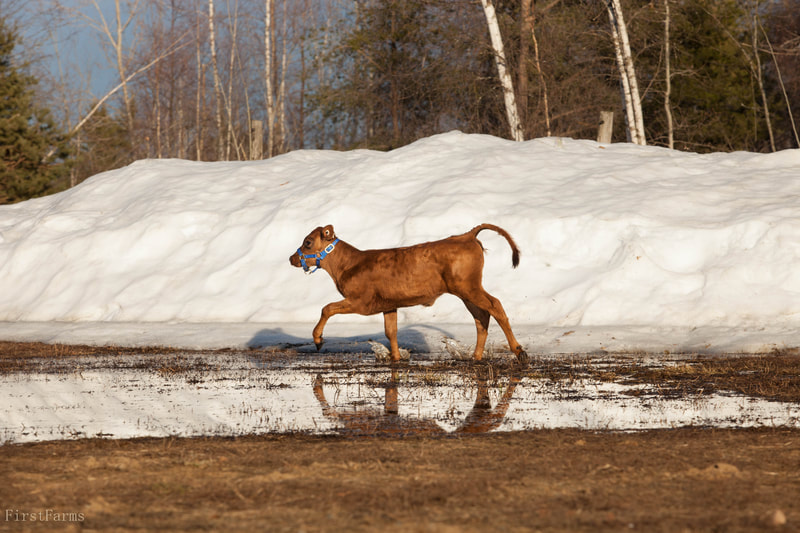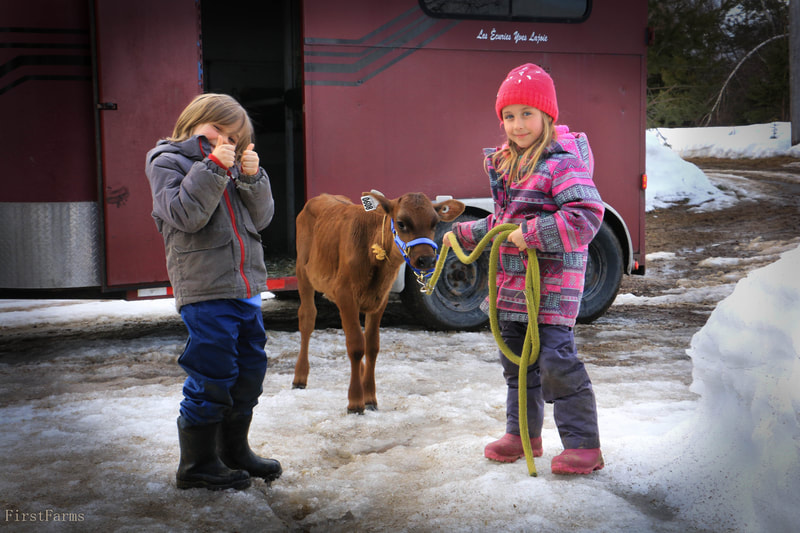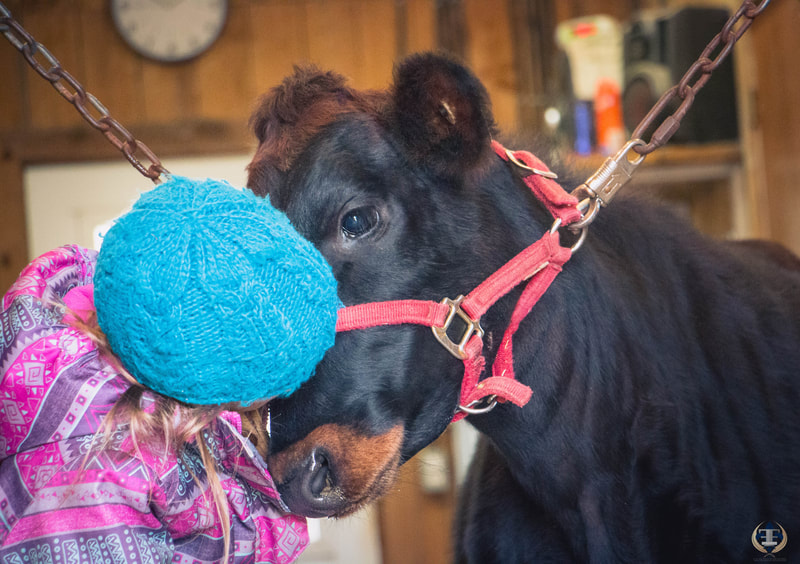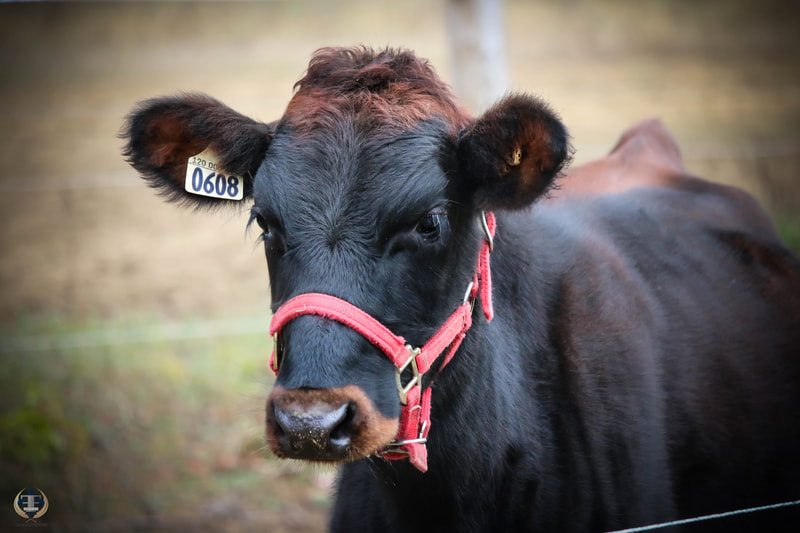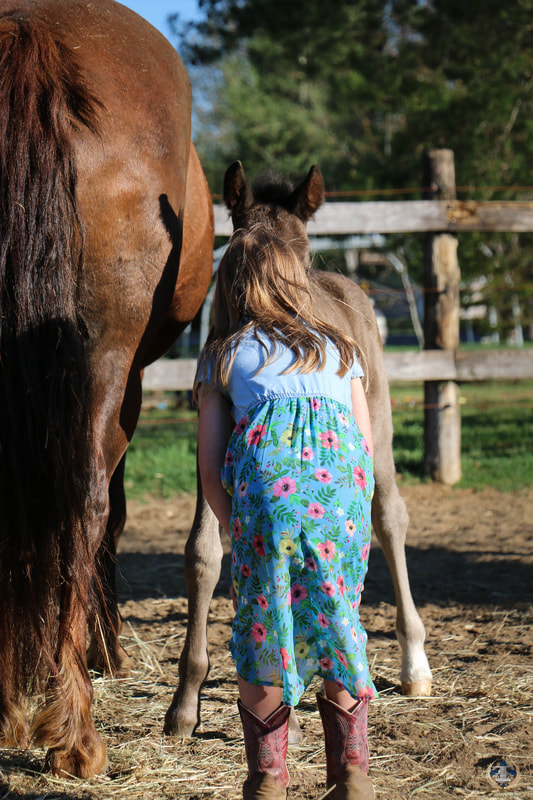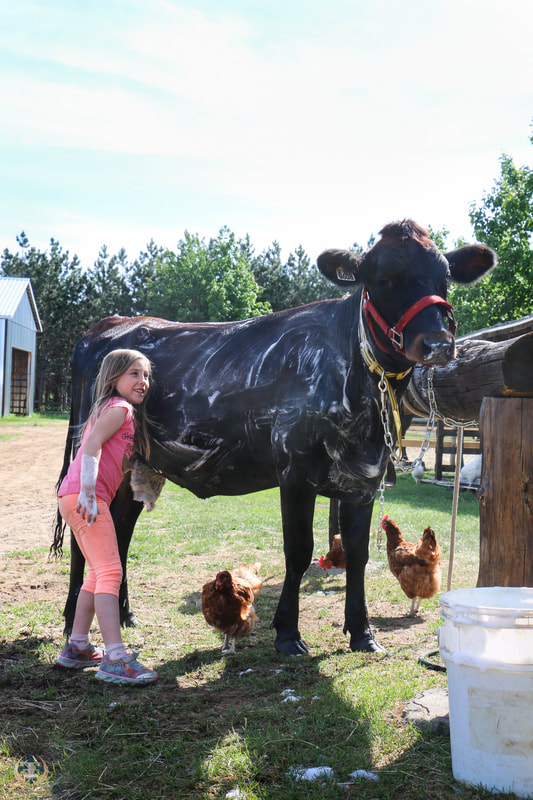Let me present you to our mascotte Miss Gigi,
Kingsey Mayllo Giovanna is our mascotte here at First Farms, we bought her at a silent auction from a breeder in Quebec she was a month old. Since, she has been raised as one of our foals and i basically think she has no clue shes a cow. Her personality is one in a million with her show off attitude and cuddly soft eyes. She is our familly cow as she supports us with our milk products. Here is a little history on our very own native cow.
Miss Gigi will have her very first calf in April 2021 and we will be looking for I names.....
The Canadienne is a dairy breed developed in French Canada from cattle imported back in the XVIIth century from Brittany and Normandy. The Canadienne is the only breed of dairy cow native to North America. At its origins, it was not the result of genetic blends and was once exclusively and intimately linked to Quebec’s terroir*. Today the Canadienne is seriously threatened. It nearly disappeared entirely due to cross-breeding with the Brown Swiss breed. Very few purebred animals remain, but a current trend towards the traditonal-type Canadienne has initiated conservancy and development efforts in regards to its genetic make-up. Its advancement is primordial to guarantee a future for this breed of French-Canadian heritage.
* Terroir: A place-based designation, intimately linked with the land, the soil and climatic conditions.The founding of Quebec in 1608 marked the beginning of a great adventure for cattle in Canada. It is likely however that most animals introduced from that date onwards were destroyed during the siege of Quebec City, between 1629 and 1632. Champlain’s return in 1633 saw bovines permanently reintroduced to this land, but it appears that the more sizeable imports took place between 1660 and 1670, under the Colbert and Talon administrations. In fact, this period is characterized by rapid cattle population growth in New France. It seems that bovine imports ceased after this period in time - probably because they could be bred, and thereby their numbers multiplied. One interesting hypothesis concerning the origins of the Canadienne cattle breed was put forth by Laurent Avon, from L’Institut de l’élevage in France. He states that New France’s rapidly developed cattle population issued from only a few ports and that genetic breeding with other different populations did not take place. He equally contends that Canadienne cattle present a unique case in history. According to Laurent Avon, cattle of French origins who contributed to the establishment of livestock in New France would have derived from undefined populations that were more of a continuum of common genetics on the coastal areas between Guingamp in Brittany and Cotentin in Normandy - landraces which disappeared long ago. In truth, due to harsh climate traditional-type cattle would have faced supreme challenges upon arriving in Canada, and reproduction would have operated on a natural selection basis, which contributed to making the Canadienne a breed unique to the Americas, and specific to Quebec.
The Canadienne represented the majority of dairy cattle until 1850, when it began to suffer from the rivalry of other newly imported breeds. In 1886, when faced with the menace of extinction of authentic Canadiennes, breeders decided to create the Canadienne cattle breed’s herd book. Official recognition of the Canadienne as a breed brought about the establishment of certain specific standards. In 1850, there were at least 300,000 Canadienne cows, but the breed’s numbers started to dwindle into significant decline from this point onwards. By 1970, there were but 5,000 to 10,000 cows. In regards to a payment system for milk based on volume, the Canadienne breed was simply overcome, likely due to the rivalry of other breeds. In fact, it was during this decade that a cross-breeding program with the Brown Swiss breed was pushed forward to improve conformity and production. This program was also supposed to allow the Canadienne to maintain and even increase its numbers. Assuredly the Canadienne improved, but the breed’s numbers did not enjoy the success anticipated. In brief, it appears that cross-breeding results were disappointing. Today the breed’s numbers fluctuate around 1,000 heads, lbut most have less than 93.75% of pure Canadienne blood (percentage required for purebred status), and possess Brown Swiss genes. Purebred or pure-blooded numbers are inferior to 250 females, of which fewer than one hundred have never been cross-bred. The Canadienne cattle breed continues to lose ground and its purebred population is in critical state, threatened with extinction. In Quebec, several individuals have recently become aware of the breed’s historical and heritage relevance and value. In Charlevoix - where 35% of all purebred females are found and the population is simply thriving - the purebred breed is at the heart of a development project involving its milk. Should the Canadienne breed be able to regain its lost importance is quite improbable, but the breed could nevertheless find a vocation that guarantees a more promising future for itself.
( This information was taken from; The Canadienne Cow - Origins & History (vachecanadienne.com)
Miss Gigi will have her very first calf in April 2021 and we will be looking for I names.....
The Canadienne is a dairy breed developed in French Canada from cattle imported back in the XVIIth century from Brittany and Normandy. The Canadienne is the only breed of dairy cow native to North America. At its origins, it was not the result of genetic blends and was once exclusively and intimately linked to Quebec’s terroir*. Today the Canadienne is seriously threatened. It nearly disappeared entirely due to cross-breeding with the Brown Swiss breed. Very few purebred animals remain, but a current trend towards the traditonal-type Canadienne has initiated conservancy and development efforts in regards to its genetic make-up. Its advancement is primordial to guarantee a future for this breed of French-Canadian heritage.
* Terroir: A place-based designation, intimately linked with the land, the soil and climatic conditions.The founding of Quebec in 1608 marked the beginning of a great adventure for cattle in Canada. It is likely however that most animals introduced from that date onwards were destroyed during the siege of Quebec City, between 1629 and 1632. Champlain’s return in 1633 saw bovines permanently reintroduced to this land, but it appears that the more sizeable imports took place between 1660 and 1670, under the Colbert and Talon administrations. In fact, this period is characterized by rapid cattle population growth in New France. It seems that bovine imports ceased after this period in time - probably because they could be bred, and thereby their numbers multiplied. One interesting hypothesis concerning the origins of the Canadienne cattle breed was put forth by Laurent Avon, from L’Institut de l’élevage in France. He states that New France’s rapidly developed cattle population issued from only a few ports and that genetic breeding with other different populations did not take place. He equally contends that Canadienne cattle present a unique case in history. According to Laurent Avon, cattle of French origins who contributed to the establishment of livestock in New France would have derived from undefined populations that were more of a continuum of common genetics on the coastal areas between Guingamp in Brittany and Cotentin in Normandy - landraces which disappeared long ago. In truth, due to harsh climate traditional-type cattle would have faced supreme challenges upon arriving in Canada, and reproduction would have operated on a natural selection basis, which contributed to making the Canadienne a breed unique to the Americas, and specific to Quebec.
The Canadienne represented the majority of dairy cattle until 1850, when it began to suffer from the rivalry of other newly imported breeds. In 1886, when faced with the menace of extinction of authentic Canadiennes, breeders decided to create the Canadienne cattle breed’s herd book. Official recognition of the Canadienne as a breed brought about the establishment of certain specific standards. In 1850, there were at least 300,000 Canadienne cows, but the breed’s numbers started to dwindle into significant decline from this point onwards. By 1970, there were but 5,000 to 10,000 cows. In regards to a payment system for milk based on volume, the Canadienne breed was simply overcome, likely due to the rivalry of other breeds. In fact, it was during this decade that a cross-breeding program with the Brown Swiss breed was pushed forward to improve conformity and production. This program was also supposed to allow the Canadienne to maintain and even increase its numbers. Assuredly the Canadienne improved, but the breed’s numbers did not enjoy the success anticipated. In brief, it appears that cross-breeding results were disappointing. Today the breed’s numbers fluctuate around 1,000 heads, lbut most have less than 93.75% of pure Canadienne blood (percentage required for purebred status), and possess Brown Swiss genes. Purebred or pure-blooded numbers are inferior to 250 females, of which fewer than one hundred have never been cross-bred. The Canadienne cattle breed continues to lose ground and its purebred population is in critical state, threatened with extinction. In Quebec, several individuals have recently become aware of the breed’s historical and heritage relevance and value. In Charlevoix - where 35% of all purebred females are found and the population is simply thriving - the purebred breed is at the heart of a development project involving its milk. Should the Canadienne breed be able to regain its lost importance is quite improbable, but the breed could nevertheless find a vocation that guarantees a more promising future for itself.
( This information was taken from; The Canadienne Cow - Origins & History (vachecanadienne.com)

